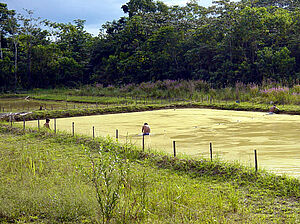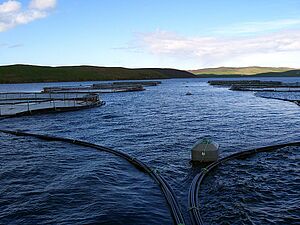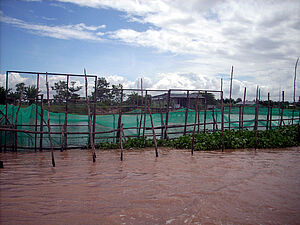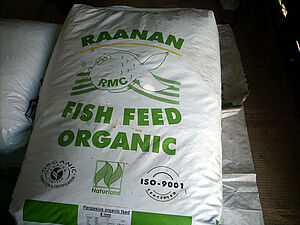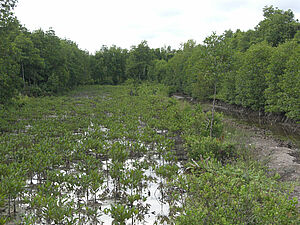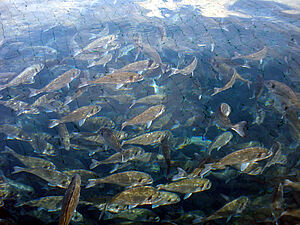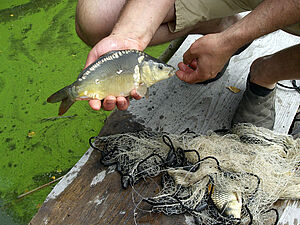Global aquaculture
Since oceans and rivers cannot provide enough fish and seafood to cover the rapidly increasing worldwide demand, aquaculture has been on the rise since the 1990s.
According to the Food and Agriculture Organization, FAO, the yield of worldwide fisheries has been stagnating for years at about 90 million tons (1995: 94 million tons, 2000: 94.7 million tons, 2003: 89.5 million tons, 2007: 91.9 million tons, 2010: 90.2 million tons, 2011: 94.9 million tons, 2012: 92.5 million tons). Yields from the entire aquaculture (fish, shellfish, algae, etc.) increased from 65 million tons in 2007 to 90.4 million tons in 2012.
On one hand, it can be seen as a positive development for providing the world’s population with fish that there is an enormous production of aquatic animals on land or in the sea, lakes and rivers through nets. On the other hand, this intense industrial aquaculture could lead to severe disadvantages such as water pollution, use of resources and land, infringement of human and animal rights and mass outbreaks of fish.
Organic aquaculture
Organic aquaculture is a relatively young field in the organic sector. By developing standards to reduce the negative aspects of conventional aquaculture, organic aquaculture has been setting examples since the beginning of the 1990s. More or less far-reaching rules were set up on the basis of private regulations of grower associations like Naturland (Germany) or the Soil Association (UK) in some countries – e.g. Spain, France and Denmark – and are sometimes integrated into the national legislation on organic farming. These rules are based on the principles of extensive livestock systems, and they implement the protection of the environment, animal welfare and, to some extent, social criteria, not excluding the aspect of profitability.
The rules are not limited to country of origin (i.e. Germany and the UK); they are international. Nowadays, they also partially apply to tropical varieties. By now, there are about 20 different standards for organic aquaculture in Europe; however, they often vary in terms of restrictions and the quality of the resulting products. A chapter on aquaculture in the EU-Eco-regulation 889/2008 (legally binding as a separate regulation 710/2009 since 1 August 2009) is supposed to bring standardization.
The varieties and production systems associated with organic aquaculture are few. Generally, there is a distinction between inland fish farming in ponds and fresh water net pens at the coasts or in rivers and lakes. In Europe, mostly carp, salmonids (trout, char, salmon) and cod are bred and fed according to organic regulations. The latest additions have been gilthead seabreams and seabass. Farming practices vary from extensive carp pond farms without feed input to semi-intensive ponds and net pens (trout; salmon, cod and Mediterranean species, respectively). In addition, organic farming of mussels and oysters is found in Europe.
In tropical and sub-tropical regions, shrimp and certain fish species (catfish, tilapia) are produced exclusively for exporting. For the regional markets, organic aquaculture is generally not of great importance, but it provides income security and supports the development of social structure and infrastructure. Simple systems, like production in ponds or net pens where the animals are occasionally fed concentrated feed, are dominant. Pond systems are often included into the surrounding ecosystems and, thus, comply with the standards of the respective certifiers. A problem that occurs in organic aquaculture as well is the dependency on trading and distributing structures. For the individual fish farmers, controlling prices and wages themselves becomes a lot harder.
Origin of raw feed material and other questions
One of the most important concerns of organic aquaculture is the sustainability of the used feed; thus, the use of conventional fishmeal should be avoided as much as possible. For carnivorous species that need animal protein in their feed, it is possible to use fishmeal produced from fish trimmings. The supply of this raw material – as of fishmeal in general – is, however, limited, given the increasing shortages of resources. Using plant-based protein has nutritional limits and carnivorous fish must not be forced to live on a vegetarian diet; hence, not only the organic sector is looking for animal alternatives to fishmeal. However, plant material can be used to create balanced foodstuff with sufficient nutrients even for predatory fish; in organic fish feed, it must be retrieved of organic production.
Other principles of organic aquaculture are – apart from organic feed – production and processing that is GMO-free along the entire supply chain (from juvenile fish to the ready and frozen meal), limitation of stocking density and a ban on artificial fertilizers, synthetic herbicides and pesticides. In principle, organic farms must have no or only little effect on the environment. For this reason, an organic fish farm needs to develop a management plan that covers measures to avoid contamination (e.g. through ammonia and nitric nitrogen as waste of food conversion) as well as periodic controls of the sewage system and the sediments. Natural plant communities, like mangroves, need to be integrated into the farm. A farm’s location is very important, because it needs to comply with certain standards for an organic certification. These standards include the water depth and current in net pens and the exclusion of contamination from the surrounding area (e.g. from intensive agriculture or neighbouring conventional fish farms.)
Another important aspect for organic aquaculture is slaughtering the animals stress-free because animal protection and welfare are crucial issues in the consciousness of the consumer. The corresponding legal requirements prescribe quick and gentle procedures; however, more research and development is required. More information on stunning and slaughtering methods for edible fish (German).
Healthy fish without the use of medication – is it possible?
So far, no consensus has been reached between the guidelines of various associations and EU-states on allowed medication or the frequency of medical treatments. They do agree on favouring natural methods in case of disease (plant extracts, homeopathic remedies), but they also allow the use of conventional medication if necessary. Conclusively, the possibilities for fish farmers to treat their stocks in case of disease are as limited as the choice of allowed medication for disinfection and prevention. This has led to an actual emergency of treatment in freshwater fish farming.
This issue becomes apparent in organic salmon farms, which are facing the same problems as the conventional farms: the salmon louse. This parasite is a small blood-sucking crustacean living on fish and creating major damage. The responsible authorities of European salmon farming nations (Ireland, Scotland and Norway) stipulated a treatment with the corresponding medication (avermectins) which is to be used as soon as the number of parasites per fish exceeds a certain value. Organic salmon is treated in the same way as conventional salmon – the only difference being the extended waiting period between treatment and slaughter (at least twice as long).
Currently, there are alternative medications and methods to get rid of salmon lice effectively without using heavy chemicals. In organic salmon farms in Ireland, for instance, a wide variety of methods is used: cleaner-fish are kept together with salmon in the same net pens and eat the parasites of the salmons’ bodies. Sonar experiments show a significantly lower infestation. Using hydrogen peroxide instead of avermectins has also proven successful. It is neither harmful to fish nor to the environment. Lastly, particular plant-based additions to feed (e.g. on the base of garlic) also decrease the number of parasites.
Demand for research in organic fish farming
There is still a need for further research, but there is hope that the use of chemical anti-parasitic agents in organic aquaculture will soon be outdated.
Another research topic is the welfare of fish, or rather animal-friendly husbandry. There is no answer found to the question of how much space each fish is entitled to in artificial waters or enclosures without violating the requirements of animal husbandry. Furthermore, it remains unclear how important it is for fish to live in proximity to nature and if closed recirculation systems can be organically certified at all or not. The majority of the current regulations and the EU regulation 710/2009 concerning the practice of organic aquaculture both rule out certification. A study about the ecological assessment of such systems also brought negative results (Nathan W. Ayer and Peter H. Tyedmers (2009): Assessing alternative aquaculture technologies: life cycle assessment of salmonid culture systems in Canada, Journal of Cleaner Production, Volume 17, Issue 3, p.362-373).
Moreover, there is a lack of data on production and profitability of certified farms. The same holds true for data on factors that can influence profitability.
Organic aquaculture also needs save strategies to help it make its breakthrough.
In Europe, no real efforts have been made so far to implement organic aquaculture into other (agricultural) branches of production, even though synergies in the field of animal feed, energy and logistics are imperative to use. Furthermore, they are ideal to develop innovations to be used also by conventional agriculture.
For reasons of food safety and product quality, the use of additives and preservatives when processing organic aquaculture products is heavily restricted, which in turn limits the range of organic products. Thus, another field for future research in aquaculture is the search for a good alternative to benzoic acid, etc.
Still remaining a niche market despite a lot of success stories
So far, almost 250 certified aquaculture farms that produce fish and other aquatic animals (especially shrimps) according to organic standards exist all over the world. Yet, the yearly organic production (several 10,000 tons) makes up only a small fraction of the worldwide aquaculture production, even though organic aquaculture farms actively contribute to the protection of the environment and to the social structure of their communities, especially in tropical and subtropical countries. The production of so-called cash crops – meaning products and food that are produced in developing countries for the sole purpose of exporting – creates work places and income in a sustainable way without leading to oppression and dependence – all in the context of organic certification. The same holds true for organically certified aquaculture. It is important for the respective set of rules to include social standards as well. Contrary to many standards under private law, the EU-Eco-regulation does not include such standards.
Idealism is not enough
In German-speaking areas, organic fish farming, too, is still a small part of the entire pond industry, which mostly produces carp (and associated species like pike-perch, tench, pike and catfish) and trout. In Austria, mostly carp pond farms switched to organic production, while in Germany and Switzerland, it is mostly trout farms.
In carp pond farming, often only a small step is necessary to achieve organic certification (for instance replacing the conventional input feed with organically certified grains or reducing the stocking density). Sales opportunities and sufficient profitability are the criteria a farm needs to consider before becoming organic. No one is going to switch to organic farming out of idealism only. This applies even more to trout farming, which is a lot more complex in terms of feeding and welfare than carp farming. Especially the allowed stocking density (which is lower in organic farming) can make or break the results. If there are less fish allowed in one pond, there will be less revenue or more use of space and work forces. However, also the higher feeding costs and the additional bureaucratic expenditures can influence the amount of the final benefit left for the pond farmer.
The crucial factor that guarantees a successful growth, however, is the market and thus the conscious customer who decides to buy high-quality products form organic aquaculture.




